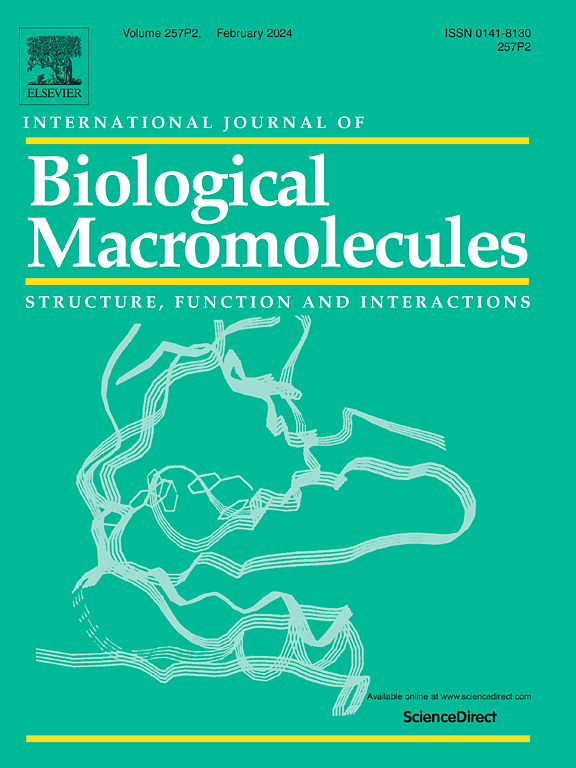Effective extraction of larch holocellulose with alkaline deep eutectic solvent and production of furan chemicals with the coordination of temperature-controlled polyoxometalates and metal salt in biphasic system
IF 7.7
1区 化学
Q1 BIOCHEMISTRY & MOLECULAR BIOLOGY
International Journal of Biological Macromolecules
Pub Date : 2025-02-01
DOI:10.1016/j.ijbiomac.2024.138721
引用次数: 0
Abstract
This study focused on extracting holocellulose from Changbai larch waste, which is rich in hexose and beneficial for furan chemicals production. Various alkaline deep eutectic solvents (DESs) was applied in the extraction of holocellulose. DES composed of lysine (Lys) and 2-aminoethanol (MEA) with strong alkalinity had a superior ability to remove lignin, and the purity of holocellulose could reach 82.7 %. Consequently, a double-acid system formed by a temperature-controlled polyoxometalates catalyst (ChnH3-nPW12, n = 1, 2, 3,) prepared by choline chloride (ChCl) and phosphotungstic acid (H3PW12O40) and different metal salts were used in the hydrolysis of holocellulose to 5-hydroxymethylfurfural (HMF) and 2-furaldehyde (FF) in a two-phase system of water and organic solvent. The yields of HMF and FF reached 43.5 % and 78.2 %, respectively, when ChH2PW12 and AlCl3 were employed under the conditions of 10 mL water/methyl isobutyl ketone (MIBK) (1:9, V:V), 9 h, and 150 °C. ChH2PW12is easy to recycle and can be used up to 5 times. This study offers a novel strategy to retain as much hemicellulose as possible to achieve holocellulose by alkaline DESs, and the one-pot process by the coordination of polyoxometalates and metal salt provides a simultaneous production of high-value furan chemicals from larch waste.
碱性深共熔溶剂对落叶松纤维素的有效萃取及双相体系中温控多金属氧酸盐与金属盐配合生产呋喃类化学品。
研究了从长白落叶松废中提取富含己糖、有利于呋喃化学品生产的全新纤维素。采用多种碱性深共晶溶剂(DESs)1进行了全息纤维素的提取。由赖氨酸(Lys)2和2-氨基乙醇(MEA)3组成的强碱度DES对木质素的去除能力较好,得到的全纤维素纯度可达82.7 %。因此,以氯化胆碱(ChCl)5和磷钨酸(H3PW12O40)6以及不同的金属盐为原料,制备温控型多金属氧酸盐催化剂(ChnH3-nPW12, n = 1,2,3,)4,在水和有机溶剂的两相体系中,将全纤维素水解为5-羟甲基糠醛(HMF)7和2-呋喃醛(FF)8。当ChH2PW12和AlCl3在10 mL水/甲基异丁基酮(MIBK)9 (1:9, V:V)、9 h、150 ℃条件下反应时,HMF和FF的产率分别达到43.5 %和78.2% %。chh2pw12易于回收,最多可使用5次。本研究提供了一种保留尽可能多的半纤维素的新策略,通过碱性DESs获得全新纤维素,而多金属氧酸盐和金属盐配合的一锅工艺提供了从落叶松废弃物中同时生产高价值呋喃化学品的方法。
本文章由计算机程序翻译,如有差异,请以英文原文为准。
求助全文
约1分钟内获得全文
求助全文
来源期刊
CiteScore
13.70
自引率
9.80%
发文量
2728
审稿时长
64 days
期刊介绍:
The International Journal of Biological Macromolecules is a well-established international journal dedicated to research on the chemical and biological aspects of natural macromolecules. Focusing on proteins, macromolecular carbohydrates, glycoproteins, proteoglycans, lignins, biological poly-acids, and nucleic acids, the journal presents the latest findings in molecular structure, properties, biological activities, interactions, modifications, and functional properties. Papers must offer new and novel insights, encompassing related model systems, structural conformational studies, theoretical developments, and analytical techniques. Each paper is required to primarily focus on at least one named biological macromolecule, reflected in the title, abstract, and text.

 求助内容:
求助内容: 应助结果提醒方式:
应助结果提醒方式:


